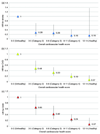Ideal cardiovascular health and risk of cardiovascular events in the EPIC-Norfolk prospective population study
- PMID: 26336197
- PMCID: PMC6215703
- DOI: 10.1177/2047487315602015
Ideal cardiovascular health and risk of cardiovascular events in the EPIC-Norfolk prospective population study
Abstract
Background: The American Heart Association has prioritised seven cardiovascular health metrics to reduce the cardiovascular burden, including: body mass index, healthy diet, physical activity, smoking status, blood pressure, glycated haemoglobin A1c and total cholesterol. The aim of the current study was to assess the association between the American Heart Association-defined health metrics and the risk of cardiovascular events in the EPIC-Norfolk prospective study.
Design: Prospective cohort study.
Methods: An overall cardiovascular health score was calculated based on the number of health metrics including ideal, intermediate or poor. Cox proportional hazards models were used to describe the association of the seven metrics separately and the overall health score with risk of coronary heart disease, stroke and cardiovascular disease. A total of 10,043 participants was included in the analysis (follow-up 1993-2008). For all individual health metrics a more ideal status was associated with a lower risk of cardiovascular events.
Results and conclusion: As for the overall cardiovascular health score, those in the highest (i.e. healthiest) category (score 12-14) had an adjusted hazard ratio for coronary heart disease of 0.07 (95% confidence interval (CI) 0.02-0.29, P < 0.001), for stroke of 0.16 (95% CI 0.02-1.37, P = 0.09) and for cardiovascular disease of 0.07 (95% CI 0.02-0.23, P < 0.001), compared to people in the lowest (i.e. unhealthiest) category (score 0-2). The overall cardiovascular health score was strongly and inversely associated with risk of coronary heart disease, stroke and cardiovascular disease. Our data suggest that even small improvements in modifiable risk factors may lead to substantial reductions in the risks of cardiovascular events.
Keywords: Health metrics; cardiovascular diseases; primary prevention; risk factors.
© The European Society of Cardiology 2015.
References
-
- Yusuf S, Hawken S, Ounpuu S, Dans T, Avezum A, Lanas F, et al. Effect of potentially modifiable risk factors associated with myocardial infarction in 52 countries (the INTERHEART study): case-control study. Lancet. 2004;364(9438):937–52. - PubMed
-
- Iestra JA, Kromhout D, van der Schouw YT, Grobbee DE, Boshuizen HC, van Staveren WA. Effect size estimates of lifestyle and dietary changes on all-cause mortality in coronary artery disease patients: a systematic review. Circulation. 2005;112(6):924–34. - PubMed
-
- Eckel RH, Jakicic JM, Ard JD, Hubbard VS, de Jesus JM, Lee IM, et al. 2013 AHA/ACC Guideline on Lifestyle Management to Reduce Cardiovascular Risk: A Report of the American College of Cardiology/American Heart Association Task Force on Practice Guidelines. Circulation. 2013 - PubMed
-
- Perk J, De BG, Gohlke H, Graham I, Reiner Z, Verschuren WM, et al. European Guidelines on cardiovascular disease prevention in clinical practice (version 2012): The Fifth Joint Task Force of the European Society of Cardiology and Other Societies on Cardiovascular Disease Prevention in Clinical Practice (constituted by representatives of nine societies and by invited experts) Atherosclerosis. 2012;223(1):1–68. - PubMed
MeSH terms
Substances
Grants and funding
LinkOut - more resources
Full Text Sources
Other Literature Sources
Research Materials


